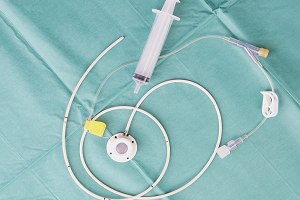

Flushing a Port a Cath
Normal saline is used to flush fluids through, a heparinized saline solution is used to maintain patency while maintaining access or to discontinue access. Usually, a Port-A-Cath is flushed with 10mL of normal saline and locked with 2.5mL normal saline mixed with 2.5mL of heparin 100 units/mL for a 5m total volume.
Instructions
Demonstration Videos
Using a Huber Needle
Guidelines, Specifications & User Manuals
Accessing Port-a-Cath Reference Guide
Evidence-Based Standards Guide the Use and Maintenance of Venous Implanted Ports
Children’s Protocols Port-a-cath
Helpful Information
How long can you leave a Huber needle in a port?
Although usage of Huber needles for central venous catheters was limited to between 48 and 72 hours, needles were not removed unless there were signs of inflammatory reaction. The needles remained in place for 28 days (1-49 days) on average.
Port needles: do they need to be removed as frequently in infusional …
www.ncbi.nlm.nih.gov › pubmed
How long can a port a cath stay in?
two to six years
Most patients are sore for four to seven days following surgery and it is best to wait five to seven days before accessing the new port. 6. How long will a Port-a-Cath last? Most surgeons say most ports will last anywhere from two to six years.
Port A Cath Fact Sheet – National MPS Society
mpssociety.org › wp-content › uploads › 2011/07 › Port-a-Cath__8-06
How can you tell if your port is infected?
Symptoms and Diagnosis of Infection
The first, pocket infection, can be diagnosed by erythema, a rash caused by infection; tenderness, pain when pressure is applied to the chest port site; induration, localized hardening at the chest port site; and purulence, pus, at the chest port site.May 12, 2017
How often do you flush a port with heparin?
Flush your port with heparin (a blood thinner) between each port use. Your port also needs to be flushed with heparin every 4 weeks when it is not being used regularly. You will use a syringe to push a small amount of saline or heparin into the port and catheter.Feb 3, 2020
Can you shower with a port?
The bandage must be kept dry until the incision is completely healed. This usually takes 5 to 7 days. You can not take a shower during this time. You can usually take a bath if the port is in your chest, but you have to keep the bandage dry.
Is accessing a port a sterile procedure?
Ports should be accessed using sterile procedure. When being handled for treatment, the end of the line outside of the body needs to be cleaned according to hospital policy with each use. Additionally, always wash hands before touching the catheter tip.Mar 12, 2018
How do you draw blood from Port?
Here’s how:
Flush the catheter.
Using the same syringe, pull to aspirate 6 ml of blood into the syringe. …
Repeat the aspiration and reinfusion at least three times.
Remove and discard the used syringe and attach a new syringe to draw the sample for the lab.
Do you always get blood return when flushing a port?
There is a reason that the port lacks a blood return, and unless a blood return is obtained—or a dye study verifies correct placement and patency of the device—it should not be used for chemotherapy administration.Oct 12, 2011
How is a port flushed?
Normal saline is used to flush fluids through, a heparinized saline solution is used to maintain patency while maintaining access or to discontinue access. Usually, a Port-A-Cath is flushed with 10mL of normal saline and locked with 2.5mL normal saline mixed with 2.5mL of heparin 100 units/mL for a 5m total volume.
Can blood be drawn from a Portacath?
1. Not all patients who have implanted ports require blood draws from their ports. … Although bloods can be drawn via an implanted port, there may be times when: i. a peripheral blood draw is required (e.g. certain labs, such as PTTs) ii.
How do you care for a port?
Caring for Your Port
Keep the port incision covered with a clean and dry bandage. …
Change the dressing over the sutures every three days or more often if soiled or wet.
Cover your dressing when showering with a heavy duty type baggie taped over the dressing.
Related Devices
Central-line-or-picc-line-dressing-change
Central Line Dressing Change A central line (PICC, port, Read more...
How to prepare and administer TPN Instructions
TPN Administered TPN administration into a vein, Read more...
Flushing a port a cath Instructions
Flushing a Port a Cath Normal saline Read more...
Dressing Change & Flush Port-a-Cath Instructions
Dressing Change & Flush Port-a-Cath A port-a-cath is a device Read more...
Access Port-a-cath Instructions
Port-a-cath A port-a-cath, also referred to as Read more...
Central Line Dressing Change Instructions
Central Line Dressing Change A central line (PICC, port, Read more...
Caring for Peripherally Inserted Central Catheter (PICC)
Peripherally inserted central catheter (PICC) PICC stands for Peripherally Read more...
Bard Medical STATLOCK® PICC Plus Stabilization Device
StatLock® PICC Plus Stabilization Device The StatLock® PICC Plus Read more...
Biopatch – PICC line Dressing Change
PICC line dressing change (Biopatch) Shows how Read more...
PICC line Blood Draw Instructions
Central Line Blood Draw Central lines are IV's which allow Read more...
Patient Learning Center